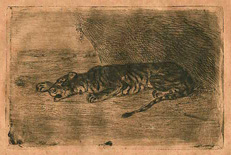
Eugène
Delacroix
Delacroix
 |
P. 96x148mm., S. 180x270mm.
Tigre Couché
à l'Entrée de son Antre
etching, drypoint, and roulette, circa 1828-30, on fine ivory laid paper, with part of a watermark in Roman capitals, a superb and unique trial proof impression of the 5th state (of 6)*, before letters, with rich burr, yet carefully wiped to reveal fine detail, probably before steel-facing, with good margins, yet somewhat irregular edges, before the first edition, annotated in pencil "Bon à tirer" and signed by L. Dumont lower right, a slight granular printing flaw in the foreground to the right, foxing and light-staining from an old mount, a water stain far lower right, general discoloration and two old gum hinges on the reverse, two pinholes above, well away from the subject, otherwise in good unrestored condition